REPLACING BOW HAIR
A couple of weeks ago, a customer of ours, who lives in Vienna, called me to tell that she was by a great French master working in her city that , after having replaced the horsehair, said that her bow was crooked and that this problem could not be solved because the material used was not seasoned enough. A cold shiver went through my back. The wood we use is of course not fresh but seasoned and of a high quality, but you may also understand that when a craftsman, especially French, let you know such a thing it means that the bow moved in an abominable way. When the bow came back to us, we felt reassured. The bow actually moved, but the fault was not ours, but because of his abominable rehairing.

In this particular case, the hair had not been properly stretched, and there was not the same tension on both sides of the bow. You see, a violin bow stick is longer than 70 cm and its diameter slightly exceeds 8 mm at its widest point, so if hair is more stretched on one side, the bow will have the tendency to move in that direction. We can see the same effect on a gig, if the tension on the harness is the same, the horses go straight, when you pull one more than the other, they turn in the direction of the increased tension.
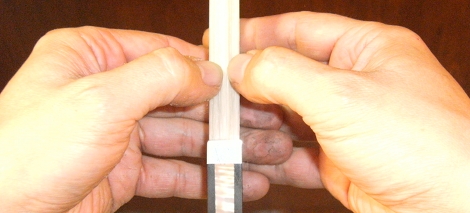
Photo 1
So if you collect a bow after rehairing and find it has become crooked but before it was not like this, try to feel the tension of the hair from both sides with your thumbs (Photo 1), and if it is not homogeneous, you have to redone it , or better , change craftsman.
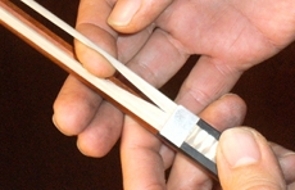
Photo 2 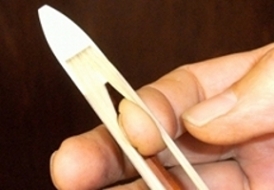 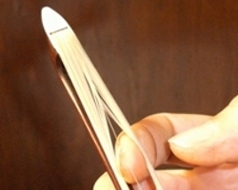
Photo 3 Photo 4
Another important aspect of the reharing is the combing. If the hair is mixed and twisted the adherence will not be uniform , and inevitably this will cause unpleasant noises. To determine if the hair is properly combed it will be useful to separate a small portion with your index finger (Photo 2), and let it run along the stick until the head. If the reharing is properly carried out (Photo 3), the adherence will be perfect, otherwise some sound problems will be evident (Photo 4).

Photo 5
When the hair is just fitted, even if the craftsman can do his job, they do not have a uniform tension, some are more tense than others. That's why you need to wet them, let them in tension, and after it finish them with fire. To check if the reharing has been properly carried out, turn the screw on the button until the hair begins to be tense , and holding the frog with your right hand, slam the head on the left side (Photo 5).
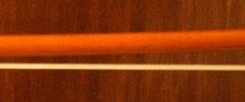 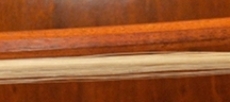
Photo 6 Photo 7
If the reharing has been properly finished, it will appear as in Photo 6, otherwise it will look like in Photo 7.
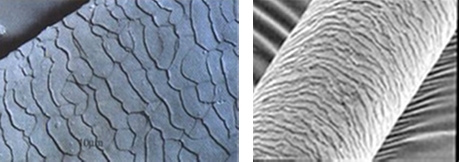
Photo 8
Another thing to take into consideration when you make a reharing is the direction of the hair. The horsehair is same as our hair, just a little stronger and with a scaled surface (Photo 8). When you carry out a reharing, in order to obtain the best results, it is essential to mount the hair with the scales towards the head. This will increase the grip at the tip, and it will easen the attack on the string in the most uncomfortable position, where the weight of the arm helps less. Checking if the hair is mounted in the right direction is very simple, you just have to watch its color. The end of the horse tail is darker than the hairline, so if the hair is properly mounted, those ones near the head will be darker than those one by the frog.
Another important element is the amount of hair used. Unfortunately, to determine whether the mounted hair quantity is too low or too high, you need the expert eye of the bow maker. The musician can nevertheless hear the sound effect. If the quantity is low, the sound will come out as very thin, on the contrary if it is too much, this will act as a damper . In this way we have disproved the legend more hair = more sound.
Small note for bass players:
As you know, on bass bows are assembled using black hair, the reason is because even if it is less flexible than the white one, it is thicker and stronger, thus ideal to get vibrations from strings with such a big diameter. But the white hair still retain its beauty even in this instrument, and for this reason bass players, perhaps trusting someone's suggestion, ask very often for a rehairing with black and white hair .
WHAT A WICKED CHOICE !
The hair, black or white, is very sensitive to moisture, it absorbs water and releases it in accordance with the percentage in the air. This is not a problem if the hair is all white or all blacks, the hair will become shorter or longer, but the combing will not be affected. If the hair is a B&W mix, the comb will be quickly damaged and you must change it. Both types of hair have in fact a different elongation coefficient to moisture, so when the change becomes significant, for example by passing from a 90% (Cremona) to a 70% (Livorno), the hair will get ruffled , with a consequent loss of adherence and attack.
Of course, these problems can be solved, it was enough to make a reaharing strictly following all rules and the bow of our customers came back in a perfect way. But changing the hair can also become a highly destructive or disabling operation for the bow. Next week we will see how this can happen.
So long
Paolo
|
 
 |